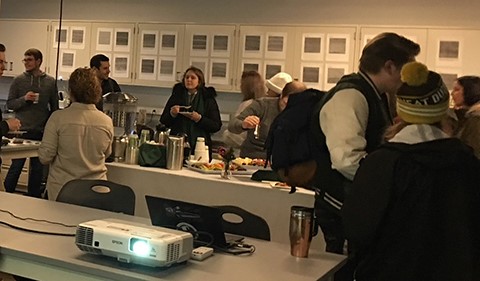
Students and faculty enjoy tour of new Anthropological Laboratories in Central Classroom at Open House event in November 2017.
The new Anthropological Sciences Laboratories in the Central Classroom building are open, and research is in full swing on collections of artifacts that help researchers reconstruct ancient environments—including those nearby in Southeastern Ohio.
Faculty and students from Sociology, Anthropology, Biological Sciences, Engineering, and the Heritage College of Medicine attended an opening event in mid-November, where they viewed artifacts and research projects while taking advantage of refreshments. A slide show cycled through images of faculty and student research projects, activities, and artifacts throughout the evening.
Dr. Sabrina Curran’s research in the laboratory is focused on two main areas: comparative skeletal morphology and 3D analysis of bone shapes and textures. With her students (and her dermestid beetle colony), she processes animal remains down to bones for the lab’s skeletal collection, which is used in both teaching and research. Also with students, she 3D-scans fossil and recent bones, which are then used in various applications, such as a digital (and transportable) comparative collection and in her research on reconstructing ancient environments.
Dr. Joseph Gingerich’s research is focused on examining changes in human settlement in North America during the last Ice Age. With students, his research involves examining stone tools to better understand how hunter-gatherer technology and resource use changes with climate, increases in population, and environment. Students are currently working with artifacts and samples from several locations in eastern North America which date between 8,000 and 13,000 years ago.
Dr. Paul Patton’s research focuses on understanding the prehistoric human diet and its application to issues of modern food security. To do so he analyzes prehistoric plant food assemblages excavated from sites located in Southeastern Ohio. Students participating in independent study courses clean, process, and analyze artifacts and archaeobotanical samples. This work has increased their methodological training, resulting in senior theses and co-authored publications and presentations.


















Comments